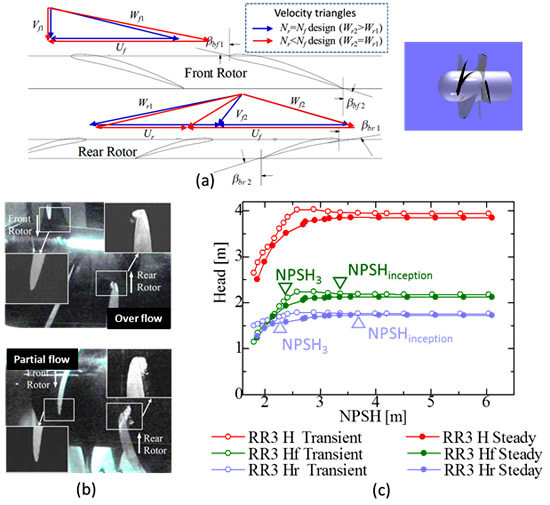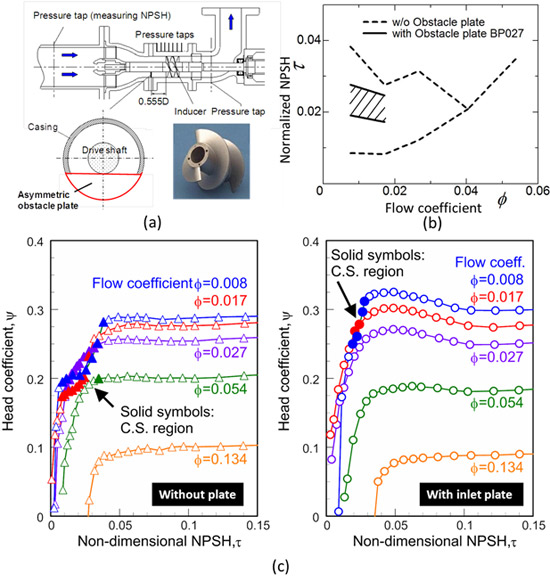Newsletter 2012.12 Index
Theme : "Fluid Machinery in Industry"
| Back | |
Studies on suction performance improvement and cavitation instabilities in turbo-pumps
|
Abstract
Cavitation is still one of the important issues in the development of high performance turbopumps. This article introduces two examples of cavitation studies being carried out in the Flow Control Systems Laboratory of Kyushu University.
A long history of development of turbopump implies that some innovative idea and technology are necessary for the remarkable improvement of cavitation performance, which cannot be done just by the blade design. We have proposed the contra-rotating rotors for axial flow pumps, since the rotational speed of rotors can be remarkably reduced for the same design specifications as those for conventional rotor stator type. A simple design with equal rotational speeds of front and rear rotors is found to give the cavitation inception in the rear rotor regardless of larger inlet pressure than in the front rotor, which is due to the larger relative inflow velocity in the rear rotor (Fig.1 (a) and (b)). To draw out the maximum advantage of contra-rotating rotors in terms of cavitation performance, the design guideline with new concept of reduced rotational speed rear rotor, in which the combination of rotational speeds of rotors is determined so as to obtain the same relative inflow velocities for front and rear rotors. The effectiveness of this design method is confirmed by CFD analysis as shown in Fig. 1(c); we can see the same NPSH criteria for the front and rear rotors. The contra-rotating rotors has additional advantages such as operational stability with string negative slope of head rise performance, high efficiency operation with individual controls of rotor speeds and so on.
Another effective method for the improvement of cavitation performance is to install an inducer just upstream of main impeller/rotor, which is often used for space rocket turbopumps. However, the cavitation instabilities such as rotating cavitation and cavitation surge are known to occur in cavitating inducers, which must be avoided in all flow rate range from overflow and shut off conditions when the inducer is employed for the general-purpose turbopumps. We have developed effective suppression methods of cavitation surge in low flow rate conditions, one of which is to install the asymmetric obstacle plate upstream of inducer as shown in Fig. 2(a). The onset region of cavitation surge is remarkably narrowed as shown in Fig. 2(b), which is achieved by avoiding the simultaneous cavitation choking in blade passages by inlet flow distortion with the obstacle plate. In addition, the increase of inducer head just above the head breakdown NPSH is observed as shown in Fig.2 (c), when the obstacle plate is installed. We are currently investigating the detail structure of cavitating flow field by flow measurements and CFD, the knowledge drawn from which will be probably useful for the development of high performance inducer.
Key Words
Cavitation, Contra-rotating axial flow pump, Inducer, Suction performance, Cavitation instabilities
Figures

Fig.1 Contra-rotating axial flow pump and cavitation performances. (a) Velocity triangles in rotors with equal speed design (blue arrows) and reduced speed rear rotor design (red arrows). (b) Cavitation inceptions in rear rotor with equal speed design. (c) CFD prediction of cavitation performance with reduced speed rear rotor design.

Fig.2 Effect of inlet asymmetrical plate installed upstream of inducer on cavitation instabilities and suction performances. (a) Inlet asymmetrical plate. (b) Reduced onset range of cavitation surge by asymmetrical plate. (c) Suction performances of inducer with and without inlet asymmetrical plate.


